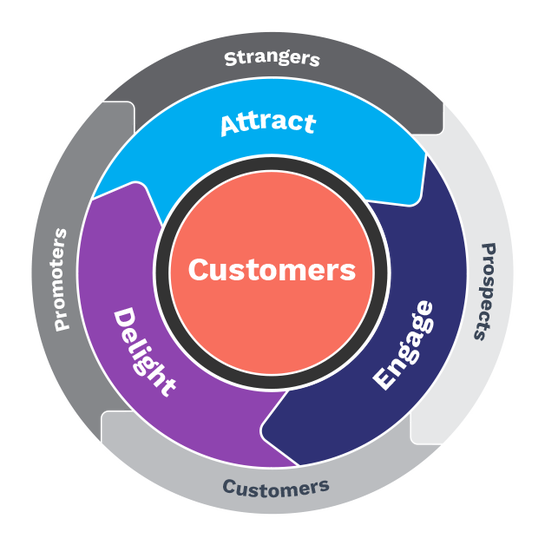If you’ve dabbled in marketing, the term “marketing funnel,” probably rings a bell. It visualizes a customer’s journey, from the first stage when they learn about your business, to the ultimate end goal: conversion. Except, what happens next? Does the customer theoretically drop out of the funnel? The idea that the funnel ends at the “conversion” stage isn’t sustainable — it costs less to keep a customer than to acquire a new one. A funnel also over-simplifies the customer journey. As many marketers know, your customer’s journey isn’t linear — there are different touches in different orders for different segments. This is where the marketing flywheel steps in.
Developed by businessman Jim Collins, the flywheel floats the idea that good-to-great transformations never happen in one fell swoop — rather, it’s a process that resembles an ever-revolving wheel. Let’s expand on this concept further and delve into why the flywheel is crucial when it comes to customer delight, retention, and overall business longevity.
What’s a Marketing Flywheel?
A flywheel is exactly what you imagine it to be: a revolving wheel that’s used to increase a machine's momentum by storing and releasing energy in a perpetual loop. Now, take that definition and apply it to marketing.
Unlike a funnel, the marketing flywheel doesn’t end when a customer reaches the bottom. Instead, it’s a continually spinning process that uses your existing customers to increase your overall business. The momentum of happy customers drives referrals and repeat sales to keep the wheel (your company) spinning as a sustainable engine.
In a traditional funnel, the stages of a customer journey are arrayed linearly starting with awareness, and often ending at purchase, or occasionally touching on referrals. The flywheel is similar, but roughly breaks things out into three sections: attract, engage, and delight.
![]()
Attract: At this stage, it’s all about awareness and getting your brand out there — you want potential customers to know about your business, product, or service. Achieve this through targeted social media advertising, display or native ad networks, and video campaigns, to name a few.
Engage: Beyond simply dropping prospects into a funnel, the marketing flywheel seeks to build meaningful relationships with customers. For example, create a community that people want to join or experiment with outreach channels.
Delight: It’s not enough to sell a product or service — the flywheel requires turning a customer’s experience with your brand into the kind of experience they want to share. Make sure to employ customer retention tactics such as satisfaction surveys, email campaigns, or chatbot support for customer inquiries.
Personalize Your Marketing Flywheel
The amount of energy a flywheel can store depends on three things: how fast it can spin, how much mass it has, and how much friction (or resistance) it encounters. The faster, heavier, and lower friction the flywheel, the more energy it has.
The way you develop your flywheel depends on the strongest areas of your business, such as your community marketing team. The key is to zone in on areas that focus on your customers’ success so that they’re more likely to share their positive experiences with others. Use this knowledge to personalize your flywheel by adding force to those areas. On the same note, look to reduce friction so that your flywheel can spin even faster and propel your company’s growth.
To begin, start asking questions such as:
- How’s your team structured?
- Why are customers churning?
- Where are prospects getting stuck in the buyer’s journey?
Why Does This Matter to You?
The flywheel forces you to take a closer look at your business — as well as the customer journey — as a whole. It gives a comprehensive picture of where your business is growing fastest and exposes areas that need improvement. And perhaps most importantly, it provides a common, company-wide goal: Keep customers happy enough to recommend your brand to others.
Every team impacts this goal. The marketing team affects how quickly prospects move through the sales process (attract), the sales process determines your shoppers’ success (engage), and the product and customer service teams influence how likely customers are to recommend your brand (delight). It’s the flywheel stages in action, and the cycle continues: The “delight” stage powers the “attract” stage because how you treat your customers affects what people hear about you, and so on.
While the funnel was created to be a good representation of how buyers used to learn about products — this might mean that people were sent newspaper ads, or talked to salespeople — nowadays, there’s an emphasis on focusing on the customer. People ask their networks for advice, search for mentions of your company on social media, and read third-party review sites. 81% of buyers trust their families’ and friends’ recommendations over companies’ marketing tactics.
Out With the Old, In With the New
Begin your flywheel journey by asking yourself, “What happens to customers when the funnel ends, and the customer experience begins?” As you work down that train of thought, you’ll begin to see little opportunities to smooth out your customer journey and improve customer advocacy. As you make small improvements, it’ll become easier to make more significant improvements. That’s the flywheel in a nutshell: small changes that play off of each other to make a big impact.
While we’re on the topic of customers, do you have a customer journey map? If not, you can create one with this template.
Last updated on September 20th, 2023.

